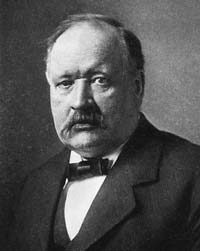
| Born: Feb 19, 1859 in Wik Castle, Sweden |
| Died: Oct 2, 1927 (at age 68) in Stockholm, Sweden |
| Nationality: Swedish |
| Famous For: Arrhenius equation, Theory of ionic dissociation, Acid-base theory |
| Awards: Nobel Prize for Chemistry (1903) Franklin Medal (1920) |
Svante Arrhenius was a renowned Swedish chemist who was born in Wik Castle, Sweden in 1859. He was awarded the Nobel Prize for Chemistry in 1905. Although generally considered a chemist, Arrhenius was also keenly interested in physics, and is widely recognized as one of the fathers of physical chemistry.
Early Life
Arrhenius showed a keen interest in academic subjects from a very early age. His parents were amazed to discover that he could read when he was only three, especially since they had not been teaching him this skill. He was also something of a child prodigy in mathematics.
He began his formal education at his local school in the town of Vik. Here he achieved distinctions in physics and mathematics. He finished his secondary education in 1876 and enrolled in the University of Uppsala to study physics, chemistry and mathematics.
Arrhenius was not satisfied with the standards of physics and chemistry teaching at Uppsala. Hence, in 1881, he enrolled in the Swedish Academy of Sciences. Here he studied under Professor Erik Edlund, the man who introduced weather stations in Sweden.
For his doctoral thesis, Arrhenius submitted a dissertation on the conductivity of electrolytes to Uppsala University in 1884. This dissertation was not well received, and he was granted a fourth class degree. Following his dispute about the low marks, it was upgraded to a third class degree.
Ions
It is unclear why the staff at Uppsala was so dismissive of Arrhenius’s dissertation. In the dissertation, Arrhenius put forward 56 theses. The most significant proposal was that salts or water were not good conductors in their pure state, but they became conductive when mixed with each other. Arrhenius proposed that the reason the solution became conductive was that salts in solution disassociated their ions. He also suggested that ions were present even when no electric current was passed through the solution. Finally, he concluded that all chemical reactions that occurred in solutions were actually reactions between ions.
International Recognition
Arrhenius was undaunted by the negative reception his doctoral thesis received in Uppsala. He mailed copies of it to several prominent scientists throughout Europe and received very positive feedback. He even received an invitation to join the research team of Wilhelm Ostwald, inventor of the Ostwald process, but he initially declined. However, he later took advantage of a grant given to him by the Swedish Academy of Sciences. He traveled to several European countries where he worked with many eminent scientists, including Ostwald.
Legacy and Death
Arrhenius’s work was groundbreaking in explaining why chemical reactions took place and describing the conditions needed to initiate a reaction. The fact that he persisted with his proposals in the face of so much opposition from academic figures in his homeland is remarkable.
He was the first chemist to suspect that levels of carbon dioxide in the atmosphere could affect climate, and he proposed an explanation for ice ages. He played a leading role in helping to create the Nobel Institute, which administers the Nobel Prizes. He died in 1927.